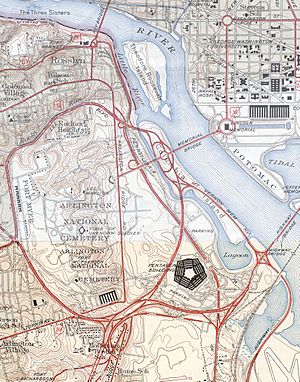Henry G. Shirley Memorial Highway facts for kids
Quick facts for kids
Henry G. Shirley Memorial Highway |
||||
|---|---|---|---|---|
| Shirley Highway | ||||
|
Shirley Highway highlighted in red
|
||||
| Route information | ||||
| Length | 17.3 mi (27.8 km) | |||
| History | Constructed and opened from 1941 to 1952 | |||
| Component highways |
|
|||
| Major junctions | ||||
| South end | ||||
|
||||
| North end | ||||
| Highway system | ||||
| Virginia Routes Primary • Secondary • History • Turnpikes
|
||||
The Henry G. Shirley Memorial Highway, often called Shirley Highway, is a major road in Virginia, U.S. It is about 17.3 miles (27.8 km) long. This highway was the first "limited-access freeway" in Virginia. This means it was built so cars could get on and off only at certain points, making travel faster and safer.
Construction on the Shirley Highway began in 1941. It was finished in 1952. The road connects U.S. Route 1 in Colchester, Virginia, to the 14th Street Bridge in Washington, D.C.. Today, parts of the Shirley Highway are known as Interstate 95 and Interstate 395.
Contents
History of Shirley Highway
The Shirley Highway is named after Henry G. Shirley. He was the leader of the Virginia Department of Highways from 1922 to 1941. Sadly, he passed away in July 1941. This was just a few weeks after he approved the start of work on this new highway.
Building the Road During Wartime
Construction started in October 1941. The first part of the road opened in October 1943. This section was near the Pentagon in Arlington, Virginia. It had two lanes at first, then four lanes by October 1944.
Because of World War II, there were limits on building materials. This meant the new highway had an unusual railroad crossing. Instead of a bridge over the Washington and Old Dominion Railroad, cars crossed the tracks at ground level. This spot was dangerous. In 1952, a train and a dump truck crashed there. The rest of the Shirley Highway was finished in 1952. It helped areas like Shirlington grow quickly during World War II. It also made it easier for people to reach shopping centers.
The "Mixing Bowl" Interchange
The new Shirley Highway included a very complex road system near the Pentagon. This area was called the "Mixing Bowl." It was finished in 1944. An "interchange" is where several highways connect and allow traffic to switch between them.
The original "Mixing Bowl" had special lanes where cars would "weave" to change highways. It was rebuilt in the 1960s. After this update, it became one of the largest interchange systems in the world. Today, this section of the Shirley Highway has many lanes and ramps. It helps connect several major roads and special lanes for carpools.
Shirley Highway Becomes I-95 and I-395
From 1965 to 1975, the Shirley Highway was upgraded. It was made to meet the standards of the Interstate Highway System. As parts were finished, they became known as Interstate 95.
Changes to Interstate Routes
Original plans for I-95 included it going straight through Washington, D.C.. However, people living in the area did not want a highway built through their communities. This "community opposition" stopped the plan in 1977. The money that would have been used for the highway was then used to build the Washington Metro subway system instead.
Because of this change, the I-95 route was moved. It now goes around Washington, D.C., on the eastern side of the Capital Beltway. The northern part of the Shirley Highway, from Springfield into D.C., was then renamed Interstate 395.
Shirley Busway: A Special Lane for Buses
On September 22, 1969, a special lane on the Shirley Highway was set aside for buses. This was between Edsall Road and State Route 7. It was called a "bus rapid transit" (BRT) route. It was the first of its kind on an Interstate highway. This special lane helped buses travel faster during busy morning hours.
The busway was later made longer. It reached the new Center Span Bridge by April 1971. This project showed that having special lanes for buses on highways could help more people use public transportation. It also helped buses stay on schedule.
The Springfield Interchange
The Springfield Interchange is a very busy spot where I-395, I-95, and the Capital Beltway all meet. It is located in Springfield, Virginia. People sometimes call this area the "Mixing Bowl." However, road officials use "Mixing Bowl" to describe the complex interchange near the Pentagon. The Springfield Interchange is a vital connection for many travelers in the area.




